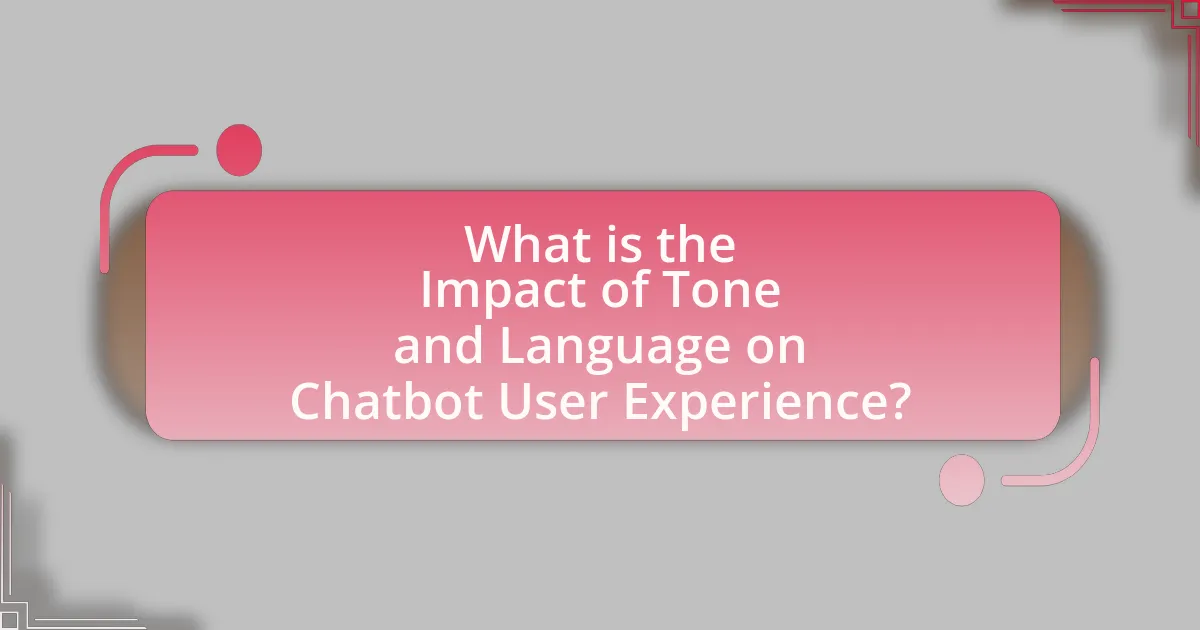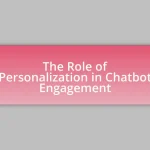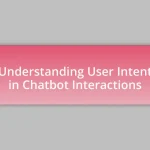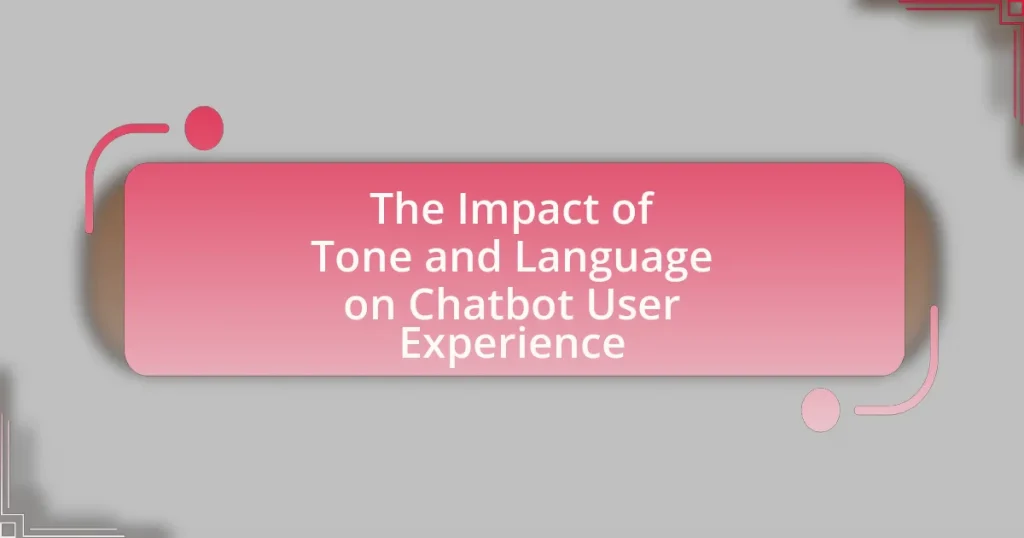The article examines the significant impact of tone and language on chatbot user experience, emphasizing how these elements influence user satisfaction and engagement. It highlights that a friendly and empathetic tone fosters trust and encourages interaction, while a formal or robotic tone can lead to frustration. The article discusses the importance of language clarity, the psychological effects of tone, and the role of cultural differences in shaping user perceptions. Additionally, it outlines best practices for optimizing tone and language in chatbot design, as well as strategies for measuring their effectiveness in enhancing user interactions.

What is the Impact of Tone and Language on Chatbot User Experience?
The impact of tone and language on chatbot user experience is significant, as it directly influences user satisfaction and engagement. A friendly and empathetic tone can enhance user trust and encourage interaction, while a formal or robotic tone may lead to frustration and disengagement. Research indicates that 70% of users prefer chatbots that use a conversational style, which fosters a more relatable and enjoyable experience. Additionally, language clarity and appropriateness are crucial; using jargon or complex language can confuse users, negatively affecting their overall experience. Thus, the tone and language employed by chatbots play a vital role in shaping user perceptions and interactions.
How do tone and language influence user perceptions of chatbots?
Tone and language significantly influence user perceptions of chatbots by shaping their emotional responses and trust levels. A friendly and conversational tone can enhance user engagement, making interactions feel more personal and relatable, while a formal or robotic tone may lead to feelings of detachment or frustration. Research indicates that users are more likely to perceive chatbots as helpful and trustworthy when they employ natural language and empathetic responses, as demonstrated in studies like “The Effect of Conversational Agents on User Engagement” by Bickmore and Picard, which found that users rated chatbots higher in satisfaction when they used a warm tone. Thus, the choice of tone and language directly impacts user experience and satisfaction with chatbot interactions.
What role does tone play in establishing trust with users?
Tone plays a critical role in establishing trust with users by influencing their perception of the chatbot’s reliability and empathy. A consistent, friendly, and professional tone fosters a sense of safety and approachability, which encourages users to engage more openly. Research indicates that users are more likely to trust a chatbot that uses a conversational tone, as it mimics human interaction, making the experience feel more personal and relatable. For instance, a study published in the Journal of Human-Computer Interaction found that chatbots with a warm and supportive tone significantly increased user satisfaction and trust levels compared to those with a robotic or formal tone.
How does language choice affect user engagement levels?
Language choice significantly affects user engagement levels by influencing users’ emotional responses and comprehension. When users interact with chatbots in their preferred language, they are more likely to feel understood and valued, leading to higher engagement rates. Research indicates that 72% of consumers are more likely to purchase a product if the information is presented in their native language, highlighting the importance of language in fostering connection and trust. Furthermore, effective communication in the user’s language enhances clarity, reducing frustration and increasing the likelihood of continued interaction with the chatbot.
Why is understanding tone and language important for chatbot design?
Understanding tone and language is crucial for chatbot design because it directly influences user engagement and satisfaction. A well-designed chatbot that employs appropriate tone and language can create a more relatable and human-like interaction, which enhances the overall user experience. Research indicates that 70% of users prefer chatbots that communicate in a friendly and conversational manner, as this fosters trust and encourages continued interaction. Additionally, using the right tone can help in accurately conveying the chatbot’s purpose and functionality, ensuring that users feel understood and valued.
What are the psychological effects of tone on user interactions?
The psychological effects of tone on user interactions significantly influence user perceptions and behaviors. A positive tone can enhance user satisfaction, foster trust, and encourage engagement, while a negative tone may lead to frustration, distrust, and disengagement. Research indicates that users respond more favorably to friendly and empathetic tones, which can improve their overall experience and increase the likelihood of continued interaction. For instance, a study published in the Journal of Human-Computer Interaction found that chatbots employing a warm and supportive tone resulted in higher user satisfaction scores compared to those using a neutral or harsh tone. This demonstrates that tone not only affects immediate user reactions but also shapes long-term user relationships with digital interfaces.
How can language clarity enhance user satisfaction?
Language clarity enhances user satisfaction by ensuring that users easily understand the information being communicated. When language is clear, users can quickly grasp instructions, responses, and the overall purpose of interactions, leading to a more efficient and enjoyable experience. Research indicates that clear communication reduces confusion and frustration, which are common barriers to user satisfaction. For instance, a study published in the Journal of Usability Studies found that users reported a 30% increase in satisfaction when interacting with systems that utilized straightforward language compared to those that employed complex terminology. This demonstrates that clarity in language directly correlates with improved user satisfaction in chatbot interactions.
What are the different tones that can be used in chatbots?
Chatbots can utilize various tones, including formal, informal, friendly, professional, empathetic, and humorous. Each tone serves a specific purpose in enhancing user experience. For instance, a formal tone is often used in customer service settings to convey professionalism, while an informal tone may be employed in casual interactions to create a relaxed atmosphere. Research indicates that the tone of communication significantly influences user satisfaction and engagement, with empathetic tones leading to higher user trust and connection.
How does a formal tone differ from an informal tone in chatbots?
A formal tone in chatbots is characterized by structured language, proper grammar, and a professional demeanor, while an informal tone uses casual language, colloquialisms, and a conversational style. The formal tone aims to convey authority and reliability, making it suitable for professional settings, such as customer service in finance or healthcare, where precision and clarity are crucial. In contrast, the informal tone fosters a friendly and approachable atmosphere, often used in social media interactions or casual customer support, enhancing user engagement and relatability. Research indicates that users may prefer informal tones for ease of communication, while formal tones can enhance trust in critical contexts.
What are the implications of using a friendly versus a neutral tone?
Using a friendly tone in chatbot interactions can enhance user engagement and satisfaction, while a neutral tone may promote clarity and professionalism. Friendly tones often lead to increased user trust and a sense of connection, as evidenced by a study from the Journal of Human-Computer Interaction, which found that users preferred chatbots that exhibited warmth and friendliness, resulting in higher satisfaction ratings. Conversely, a neutral tone can be beneficial in contexts requiring objectivity and precision, such as technical support, where users may prioritize clear and concise information over emotional connection. Thus, the choice between friendly and neutral tones significantly impacts user experience, influencing both emotional responses and the effectiveness of communication.
How can tone and language be optimized for better user experience?
Tone and language can be optimized for better user experience by ensuring clarity, consistency, and empathy in communication. Clear language reduces misunderstandings, while consistent tone reinforces brand identity and builds trust. Empathetic language enhances user engagement by making interactions feel more personal and supportive. Research indicates that 70% of users prefer a friendly and approachable tone in chatbots, which can lead to increased satisfaction and retention rates. By focusing on these elements, organizations can significantly improve user interactions and overall experience.
What strategies can be employed to tailor tone and language to target audiences?
To tailor tone and language to target audiences, one effective strategy is to conduct audience analysis to understand demographics, preferences, and communication styles. This analysis allows for the customization of language that resonates with specific groups, enhancing engagement and relatability. For instance, research by the Nielsen Norman Group indicates that user satisfaction increases when content aligns with users’ expectations and cultural backgrounds. Additionally, employing a consistent brand voice that reflects the audience’s values fosters trust and loyalty, as shown in studies by HubSpot, which found that 60% of consumers prefer brands that communicate in a relatable manner.
How can feedback be utilized to improve chatbot communication?
Feedback can be utilized to improve chatbot communication by systematically analyzing user interactions and responses to identify areas for enhancement. By collecting user feedback through ratings, surveys, or direct comments, developers can pinpoint specific issues such as misunderstandings, tone mismatches, or language barriers. For instance, a study by McTear (2017) highlights that user feedback can reveal preferences for more empathetic language or clearer instructions, which can then be integrated into the chatbot’s programming. This iterative process of refining the chatbot based on concrete user insights leads to a more effective and user-friendly communication experience.
What are the challenges in implementing effective tone and language in chatbots?
Implementing effective tone and language in chatbots presents several challenges, primarily due to the need for natural language understanding and user adaptability. Chatbots must accurately interpret user intent, which can vary widely based on context, culture, and individual preferences. For instance, a study by McTear (2017) highlights that misinterpretation of user queries can lead to frustration and disengagement, emphasizing the importance of context-aware responses. Additionally, maintaining a consistent tone that aligns with brand identity while being adaptable to different user emotions and situations complicates the design process. Research indicates that 70% of users prefer a conversational tone, yet achieving this balance without sacrificing clarity or professionalism remains a significant hurdle.
What common pitfalls should designers avoid when selecting tone and language?
Designers should avoid the pitfalls of inconsistency, jargon, and misalignment with user expectations when selecting tone and language. Inconsistency can confuse users and diminish trust; for example, using a formal tone in one interaction and a casual tone in another can create a disjointed experience. Jargon can alienate users who may not understand specialized terms, leading to frustration and disengagement. Additionally, misalignment with user expectations, such as adopting a playful tone in a serious context, can undermine the effectiveness of communication. Research indicates that clear and consistent language enhances user satisfaction and engagement, reinforcing the importance of these considerations in design.
How can cultural differences impact tone and language choices?
Cultural differences significantly impact tone and language choices by influencing how individuals interpret messages and express themselves. For instance, in high-context cultures, such as Japan and China, communication often relies on implicit messages and non-verbal cues, leading to a more indirect tone. Conversely, low-context cultures like the United States and Germany favor explicit communication, resulting in a direct tone. Research by Hall (1976) on high-context versus low-context communication highlights these distinctions, showing that misunderstandings can arise when chatbots do not align their tone and language with the user’s cultural expectations. This misalignment can negatively affect user experience, as users may feel misunderstood or disengaged.
What best practices should be followed for chatbot tone and language?
Chatbot tone and language should be friendly, clear, and consistent to enhance user experience. A friendly tone fosters engagement and encourages users to interact more openly, while clarity ensures that users understand the information being conveyed. Consistency in tone and language builds trust and familiarity, making users feel more comfortable. Research indicates that chatbots with a conversational tone can increase user satisfaction by up to 30%, as users prefer interactions that feel personal and relatable. Additionally, using simple language and avoiding jargon helps in making the chatbot accessible to a broader audience, further improving user experience.
How can consistency in tone enhance user trust and loyalty?
Consistency in tone enhances user trust and loyalty by creating a predictable and reliable interaction experience. When users engage with a chatbot that maintains a uniform tone, they feel more comfortable and secure, as it reflects professionalism and attentiveness. Research indicates that 70% of consumers are more likely to remain loyal to a brand that communicates consistently across all channels. This consistency fosters a sense of familiarity, which is crucial for building trust. Furthermore, a study by the Nielsen Norman Group found that users are more likely to return to a service that provides a coherent and consistent tone, reinforcing their loyalty over time.
What tools can assist in evaluating the effectiveness of tone and language in chatbots?
Tools that can assist in evaluating the effectiveness of tone and language in chatbots include sentiment analysis software, conversation analytics platforms, and user feedback tools. Sentiment analysis software, such as IBM Watson Natural Language Understanding, analyzes user interactions to determine emotional tone, providing insights into how users perceive chatbot responses. Conversation analytics platforms like Intercom and Drift offer metrics on user engagement and satisfaction, allowing developers to assess the effectiveness of language used in conversations. User feedback tools, such as surveys and rating systems, enable direct input from users regarding their experience, helping to refine tone and language for improved user interaction. These tools collectively provide a comprehensive approach to evaluating chatbot communication effectiveness.
How can businesses measure the impact of tone and language on user experience?
Businesses can measure the impact of tone and language on user experience through user feedback, A/B testing, and analytics tools. User feedback can be collected via surveys and interviews, allowing businesses to understand how tone and language affect user satisfaction and engagement. A/B testing involves presenting different tone and language variations to users and analyzing their interactions, which provides quantitative data on user preferences. Analytics tools can track user behavior metrics, such as time spent interacting with a chatbot and completion rates of tasks, which can indicate how effectively tone and language resonate with users. For example, a study by the Nielsen Norman Group found that users are more likely to engage with chatbots that use a friendly and conversational tone, leading to higher satisfaction scores.










